


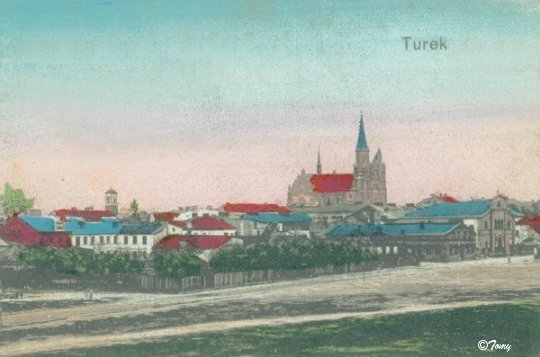
Turek, 1930s, reproduction by
Tomasz Wisniewski
(contributed by Susan Pentlin PhD)
First Email | Maps | History (Hebrew) | Kowale Pańskie | Kibel | Kibel's Memoirs | Szubinski | Chelmno | Landsmanschaft | Necrology Hebrew English | Yizkor Book | English | Bais Yaakov | Commemoration 2003 | Today
![]()
This page is in memory of the Bajrach and Kibel families of Turek and Dobra who perished at Kowale Pańskie and Chelmno. This page is also in memory of the Szubinski Family from Turek who perished at Chelmno, Posen and Treblinka and is dedicated to all the Jews of Turek brutally killed by the Germans during the Holocaust.
![]()
This web site is the result of the blessed
initiative of Dr. Susan Pentlin from the U.S.A.
(email: pentlin "at" ucmo.edu replace "at" by @ to avoid spam) in honor of
Bronia Kibel with
the support of Moshe Shubinsky from England (email:
mocki.shubinsky
"at" btinternet.com) and Ada Holtzman (ada "at" zchor.org) from
Israel.
This is work in process and will never be finished, like the memory of the holy community of Turek will never fade away! I shall be pleased and proud to post any other documents, photos, testimonies or lists which belong to the life and history of the Jews of Turek.
This was the first email I received from Dr. Susan Pentlin, and then more than hundred other emails followed it until the web site was ready.
email: pentlin "at" ucmo.edu (replace "at" by @ to avoid spam) pentlin@ucmo.edu
Dear Ada,
I wanted you to know how useful and moving I find your web site
zchor.
I hope to be able to add to your page in the future. I am working with a
Holocaust survivor from Turek, Poland. I have studied the Holocaust many years
as a professor and have known Brucha Kibel for at least twenty years, but did
not really understand what happened to Jews in the Konin-Poznan-Kalisz area
until I started to help her write her memoirs nor did I know how little is known
to scholars about what happened in this area. You probably know that only a
handful of Turek Jews survived the Holocaust. Brucha and her family, parents
Hersz Lajzer and Bluma Bajrach Kibel and siblings Chana, Jehoshua and
Ruhal were
first in the Turek ghetto and then sent to a "Judenkolonia" or agricultural
ghetto at Kowale Pańskie. From there she was part of a selection that was sent
to Inowroclaw Straflager, then to work on a farm at Gnojno and in 1943 she was
sent to Auschwitz. She was liberated at Salzwedel Camp in Germany. I was
wondering if you know anyone who was in Kowale Pańskie (also known as Heidemühle
or Czachulec as the name of the village nearby). One source I have found in Poland indicates that Brucha (today
Bronia) may be only one of two people to survive and the other man was killed by
the A.K. Armja Krajowa in 1946. Do you have any information on what occurred in
Kowale Pańskie? We have the Yizkor book and have had parts of it translated as
well, but even there you find little about Kowale Pańskie. Some sources indicate
that from Kowale Pańskie there were transports to
Chelmno, but others that the
Jews there were killed in the woods and buried in the forests near Czachulec in
July 1942.
Sincerely, Susan Pentlin, PhD
email: pentlin "at" ucmo.edu
(replace "at" by @ to avoid spam)
Professor at the University of Central Missouri.

![]()
172.2 kilometers West of Warsza
18° 30' 52° 02'
|
|
![]()
פנקס הקהילות
אנציקלופדיה של היישובים היהודיים למן היווסדם ועד לאחר שואת מלחמת העולם השנייה
פולין
כרך ראשון: לודז' והגליל
יד ושם – רשות הזיכרון לשואה ולגבורה
ירושלים תשל"ו (1976)
Encyclopedia of Jewish Communities
Poland
Vol I
The Communities of Lodz and Its Region
Published by Yad Vashem, Jerusalem 1976
Turek
(Turek Province)
Pages 130 - 131
Coordinates: 52°02' / 18°30'
Written by Aharon Weiss
Translated by M. Shubinsky
Edited by Ada Holtzman
The Population Structure
|
The Jews |
General Population |
Year |
|
| 33 | 764 | 1808 | |
| 95 | 2,302 | 1827 | |
| 653 | 4,773 | 1857 | |
| 2,072 | 8,111 | 1921 | |
| 2,700 | ? | 1.09.1939 | |
Turek as a city was church property until the partition of Poland. City charter was granted in 1357. The first Jews appeared in Turek at the beginning of the 19th century partially from nearby Dobra and for a few years the Jews in Turek were attached to the institutions of this community. They used to bury their dead in the cemetery of Dobra. A Cholera epidemic in 1830/1 killed many Jews and the community dwindled in numbers. But, by the middle of the 19th century, Jewish population grew again at a fast rate and contributed to the growth of the textile industry in the town. They were also active in commerce, oil, matches and soap manufacture. Jews also owned textile dye plants.
On Yom Kippur 5618 (27/10/1857) the synagogue was set on fire following a hate campaign by a Polish priest but a new one was built by 1861 in “Breiter Gasse”, the structure was renovated and expanded in 1910. A fire consumed 40 Jewish houses in 1878.
The Polish revolt of 1863 saw the participation of Jews such as Mordechai Manes, a medic from Turek. Another Jew was the deputy mayor during the revolt. In February 1889 local farmers attacked Jewish merchants and many were injured and their property was robbed.
It appears that Turek’s community became independent by the middle of the 19th century. From 1850 to the middle of the 1870’s the rabbi of Turek was R' David Haim Braun. He was followed by R' Hirsz Leib Waksman. 1906 saw the establishment of a yeshiva (Talmudic college). In 1899 a charity “Gemilut Hasadim” (making righteous deeds) was started. Many other organizations started at that time- Linat Tzedek (shelter of the poor and homeless), Hachnasat Kala (dowry collected for the poor bride) and the Ahiezer Society for mutual support. A primary government school for Jewish children was set up in 1886.
Zionism came to town in 1912 and at the end of 1916 the "Ttzeirei Zion" (Youth of Zion) association was set up with 100 members. It run Hebrew classes for 40 pupils and a library. By 1917 many more associations started to operate – the youth culture association ("Kultur Jugend Farjen") and sport association "Turek Farjen". By 1918 the Tehia club (the revival club) with a chorus was started, the Zamir ( the nightingale ).
In the interwar years Turek Jews carried on as artisans and small merchants. By the 1920’s there were 138 Jewish workshops, 51 of which employed workers and the rest just the owners. Amongst those were 68 confectioners, 46 cloth manufacturers, 3 metal workshops, 6 food production, 4 leather workers and one stonemason. The number employed in artisanship was 260. An artisan association was established and it initiated the establishment of a cooperative bank. In 1924 the needle worker union was first organized
Turek had a large number of Zionists parties: the Mizrachi, Zionim Klaliim - General Zionists (Al Hamishmar - on guard and Et Livnot – time to build), Poalei Zion (the workers of Zion) and the Revisionist movement. In 1926 the Hashomer Haleumi youth movement, part of the General Zionists party was set up and turned into the "Hanoar Hazioni" - Zionist Youth Movement in 1931. Turek also had a Beitar association. In the Zionist camp the Mizrahi and the General Zionists were most influential. The Zionist congresses in 1930’s saw elections and the number of voters were- 450. In 1937 the votes cast were as follows- Al Hamishmar 77, Et Livnot 89, Hamizrachi 149, Haliga Haovedet (the Working Israel league) 69.
After the First World War the Agudath Israel and Poalei Agudath Israel was organized. The Bund was also active in Turek with their youth movement the “Tsukunft”.
The Rabbi, R' Pinhas Halevi Wajngrob officiated from 1924-1932. He was one of the founders of Agudath Israel in Poland. The last rabbi was R' Pinchas Weiss who accompanied the community on its last journey during the holocaust.
After the end of WWI, the Mizrahi opened a modern Heder and a Jewish kindergarten. Agudath Israel opened an elementary school: "The Torah". Important role in the cultural life of the community served amateur theatre. There were also operating sport associations: Shomria, Bar Kochva and Trumpeldor affiliated to the Zionist youth movement and the Bund youth movement "Morgenstern".
It is worthwhile pointing out that the Jewish sculptor and painter Hanoch Heinrich Glicenstein (1870 – 1942) was born in Turek in 1870 and left it in 1887. He received in his hometown traditional education and he kept ties with his townspeople until his last days.
The outbreak of war in 1939 saw the immediate confiscation of Jewish goods and slave labor kidnapping. These forced laborers were used to repair war damaged roads and bridges. In just a few days the Germans took hostages and 15 were murdered. In November 1939, 700 Jewish men were held in the synagogue and sent to Kolo and then to Bochnia near Krakow for slave labor.
For a time the community tried to keep in touch with the deportees in Bochnia by sending them food parcels. After a while some of the deportees were sent to Międzyrzec and the link between them in the Generalgouvernement area and Turek was severed. By January 1940 the process of confiscating Jewish properties and shops was complete and the synagogue was set on fire and destroyed. In February 1940 some of the Jews were relocated to a special area in the "Breite Gasse". By July 1940 all the remaining Jews were moved into what now became the Turek Ghetto. At first people could leave the Ghetto and tried to survive by selling property to buy food. Many were starving and the Judenrat, headed by Herszel Zimnawoda, initiated actions for mutual aid, like: a soup kitchen. Mordechai Strikowski was the commander of the Jewish police. In the summer of 1940 60 Jews were kidnapped by the Germans for forced labor in Poznań and a few weeks later 30 more were taken. With the worsening situation, Jews were leaving and seeking shelter in Warsaw some even going to the Soviet zone in Eastern Poland. By 1940 there were only 1750 Jews remaining in Turek.
In October 1941 on Yom Kippur the liquidation of the ghetto started and the Jews were taken to rural ghetto in the region of Kowale Pańskie, south of Turek where many Jews of the area were concentrated.
__________
Sources:
· Yad Vashem Archives, Jerusalem: M-1/E 887/759; 03/3507.
· The Central Archives for the History of the Jewish People, Jerusalem: HM8200, HM 8120, HM 7526.
· Central Zionist Archive, Jerusalem: S.5-1801, S.5-1796, S.5-1707.
· Material for the Yizkor book of Turek, by permission of the Organization of the Former residents of Turek in Israel: testimony of Eliezer Orbach and Icchak Orbach; testimony of Jonas Fersenszajn; article of Szraga Bar Sela.
· Sz. Gilboa, Di Din Torah, in "Fon Letzten Hurban" 1947, Heft 6.
· "Arbeter Zeitung" (Lodz) 31/10/1949; "Der Weker" 3.5.1933; "Hatzfira" 1878, 1884, 1887, 1893, 1897, 1912, 1914, 1917, 1918, 1920; "Kaliszer Woch" 6.5.1932; "Kaliszer Leben" 7.3.1930, 3.3.1931; "Izraelita" 15.6.1877, 20.7.1877, 28.9.1899, 12.6.1908.
______________
Translator’s comment
The Turek synagogue was damaged by fire but not destroyed. It was used as a storehouse after the war and is now the Turek Cinema. The front of the building had been removed recently when the cinema was built.
The town acknowledges the synagogue value to the Jewish people but refuses to renovate it.
![]()
(The District of Turek)
Page 221
Coordinates: 51°56' / 18° 33'
Translated by Ada Holtzman
Pinkas Hakehilot
Encyclopedia of Jewish Communities
Poland
Vol I
The Communities of Lodz and Its Region
Published by Yad Vashem, Jerusalem 1976
In the rural district of Kowale Pańskie only a few Jewish families lived before September 1939. During the Nazi occupation, on 20/10/1941, about 4,000 Jews from the district of Turek were deported to 16 villages around Kowale Pańskie. This Ghetto was also known as ghetto Czachulec, named after one of the villages around the area. The deportees were of the following communities in the neighborhood: Turek, Dobra, Uniejów, Władysławów, Pęczniew, Tuliszków and Brudzew. The Jews who were transported there, were scattered among the farmers, part of them lived in barns and other shattered buildings. Many of them remained a long period without any shelter in the field. They were employed in agricultural works and pavements of roads in the region.
A Judenrat for all the communities was founded, headed by Herszel Zimnawoda. The Judenrat took care of problems which arose from the relations with the local peasants. On November 4th, 1941, the Judenrat was ordered by the Germans to prepare a list of Jews who were incapable for work, and include also children under 12 and elders over 65 years old in the list of the "disabled for work". The chairman of the Judenrat did not want to take responsibility on such a list and asked the opinion of Rabbis who were among the deportees in the region of Kowale Pańskie. In the consultations that followed the following Rabbis participated: R' Dow Ber Issachar from Dobra; R' Pinchas Weiss from Turek; Rabbi Lewental from Uniejów and the Rabbi of Władysławów. After stressful discussions that lasted 2 days, the rabbis determined that the Judenrat chairman would submit the ordered list to the Germans. In order to save as much people as possible, the children age was increased and the age of the elders decreased. Part of the Jews who appeared on the list managed to escape to places in the Kalisz region where there were still Jews.
On November 8th, 1941, all the Jews from ghetto Kowale Pańskie were gathered in the village of Bielawki and there a selection was conducted. The Germans did not rely on the lists prepared by the Judenrat and they decided by themselves who will stay and will be deported. It was said that the commander of the Jewish police, Mordechai Strikowski helped to save children during the selection.
About 1,100 people who were declared as "incapable for work" were transported to the small town of Dobra and held for a few days in the local church overcrowded, under terrible conditions, without food or water. Many died in the church itself. Few tens of Jews managed to escape from the church in Dobra. The others were deported on 13-14.11.1941 to the death camp of Chełmno1).
Among the Jews who remained in Kowale Pańskie, a group of men was transported to forced labor near Poznań on Shavuoth (Pentecost) 1942. On June 20th, 1942, also some women were deported there. On June 23rd, 1942, 10 Jewish policemen were hung in a public execution. On July 20th, 1942, the liquidation of who ever remained in the ghetto of Kowale Pańskie started. The sick were murdered near one of the hill, some distance from the gathering place. The bandager Z. Stein did not wish to leave his sick patients so was shot with them. During the last aktzia (Action) other 12 Jewish policemen were murdered. All the rest were deported to the extermination camp Chełmno.
___________
Sources:
Yad Vashem Archive, documents: M-1/E 887/758, M-1/E 887/759, M-1/E 2171/1946
Sh. Gilboa – Di Din Torah, in "fon letzten hurban" 1947, heft 6
Y. Waldman, di Chelmner tragedie, in "fon letzten hurban" 1946, heft 1.
1) The Polish researcher Krzysztof Gorczyca from the Konin Regional Museum comments: that the mass murder was 13-14.12.1941. He states that Chelmno began his activity since 8.12.1941. He adds:
"Sonderkommado Lange really began murdering Jews in September, Oktober and beginnig of November 1941, but not in Chelmno. They murdered Jews from rural ghettos Zagorow, Grodziec and Rzgow in forests near Rudzica and Kazimierz Biskupi in Konin area. To Chelmno they came about 15.XI.1941.
In the last months we edited a book 'Chelmno Witnesses Speak' in English. There you can find all information.
In original testimony of J. Waldman from 1945 are date December 13-14, 1941.
IThere are other sources."
![]()
|
|
|
|
|
|
|
Partial List of the Holocaust Martyrs of Turek (Hebrew) (English)
Partial List of the Martyrs of Rychwal (Hebrew) (English)
Partial List of the Martyrs of Tuliszkow (Hebrew) (English)
![]()
![]() Bronia
(Brucha) Kibel of Turek, Poland
Bronia
(Brucha) Kibel of Turek, Poland
Holocaust Survivor
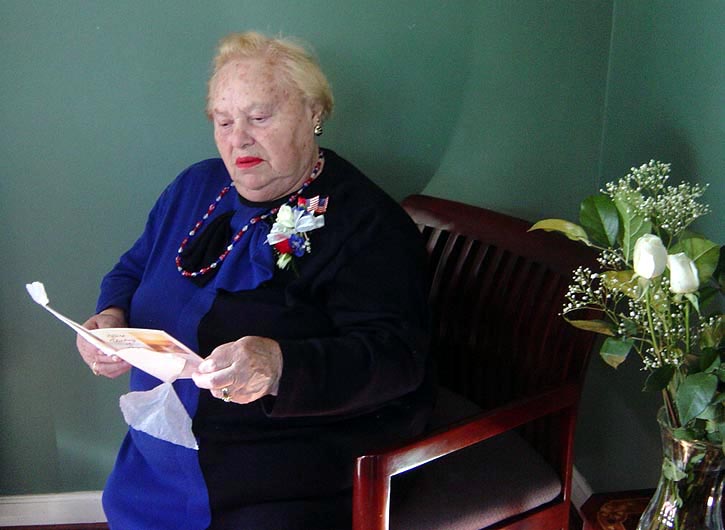
Bronia was born in 1926 in Turek, Poland. Meyer Shlomo Bajrach, grandfather, owned a row of houses on Ogrodowa where several families lived before the Holocaust. The family of Hersz Leiser Kibel lived at Ogrodowa 10, Turek.
When the Nazis came to Turek in 1940, she was relocated to a ghetto. From there she was sent to three concentration camps, Inowroclaw in 1940, Gnojno from 1941-1943 and Auschwitz from 1943-1944. She then was sent to a labor camp, Reichenbach, on a death march to Zalcweidel, and then to Nederzachsen from which she was liberated in April, 1945. After the war, she studied English and worked as a nurse at displaced persons camps in Germany. She came to the United States in June, 1947.
![]() Girl Friends
Girl Friends

This is a picture of Bronia Kibel and her girl
friends in Turek, Poland, probably in 1938 or 1939. Bronia is on the left
(she is the shortest of the three girls). Bronia was born Brucha Kibel
in Turek in 1926. Her parents were Bluma Bajrach and Hersz Leiser
Kibel. Someone gave her the photo in Israel a few years ago. The two friends
are Edka Landau (in the middle) and Henia Zomer (Somer).
Both girls were school friends of Bronia’s in Turek. Her older sister was
their leader in the basu from their Bais Yakov School. She says, the two girls
were her best friends. In Birkenau they were all three on block 13b, camp A. In
Turek, the Zomers lived on Kałagass (Kaliska). Her father made pots and
pans.
Etka Landau’s father was a bookkeeper. She lived on Kaliska Street.
Bronia remembers that Henia Zomer was on the truck taking them to the
gas chamber. Bronia jumped down, but Henia was afraid and did not
want to jump. They both perished in the Holocaust.
Holocaust Survivor
Zeew Kibel wrote a book about his experiences in the German Concentration and death camps:
|
הסנה איננו אכל נכתב וצולם ע"י ר' זאב קיבל הי"ו "הלא זה אוד מוצל מאש" (זכריה ג:2) י"ז אלול תרצ"ט - י"ז אלול תשמ"ט לזכר חמישים שנה מהכרזת מלחמת העולם השניה ותחילת השמדת ששה מליון יהודים כל הזכויות שמורות © זאב קיבל הפלוגה הדתית 4 בני ברק 51389 טלפון: 00-972-3-6194176 |
|
|
In Fire and Blood - The Bush Was Not Consumed Is not This a Brand Plucked Out of The Fire? (Zechariah (III:2) 50 Years after the Outbreak of WWII Jerusalem: Ma’arekhet Mekon Zekher Naftali, 1989. 2 volumes.
Susan Pentlin adds: Zeew Kibel was deported from Turek in July 1941 and sent to the Eichwald Labour Camp near Posen. After Posen he was in the Lodz ghetto. Bronia saw him in Auschwitz as he arrived. He survived Auschwitz, Dachau and Sachsenhausen... He returned to Turek in 1990 and I believe the book has a section about his visit there when he was searching for Torah commentaries by R' Pinchas Weiss, the last rabbi of Turek. He did not locate them. He said somewhere in the book that he owed his life to God and his sister Brucha.
|
|
![]()
The End: ChełmnoDeath Camp for Total
Extermination

מחנה ההשמדה בחלמנו על נהר הנר (דו"ח חקירה 1946)
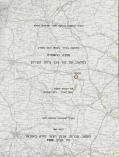
ולאדיסלאב בנדרז' ( (Władyslaw Bednarz(שופט חוקר מחוזי): דו"ח הועדה הראשית לבדיקת פשעי הגרמנים בפולין. הדו"ח שנכתב זמן קצר אחרי תום המלחמה, הובא לארץ על ידי מר. זאב קיבל, תורגם במלואו על ידי רפאל יכין מארגון יוצאי טורק בישראל והוצא לאור על ידי הארגון, ת"א 1988.
חקירת העד מיכאל פודכלבניק (Michał Podchlebnik) מיום 9.6.1945 בקולו (Kolo), פולין
![]()
Association of Yotzei Turek
in Israel
Raphael Yechin,
Kalischer Street 5, Kfar Saba 44380
Israel
Telephones: home 972-9-765-9001
Yehuda Widawski,
Dizengoff 35, Tel Aviv 64282
Israel
Telephones: home 03-528-5947; work 03-537-3525

The first public bus in Turek, route: Konin - Turek - Łódż
![]()
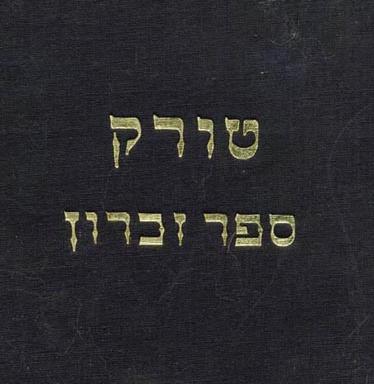
ספר זיכרון לקהילת טורק וקדושיה
הוצא לאור ע"י ארגון יוצאי טורק בישראל, תל אביב 1982
עורך: אליעזר אסתרין
TUREK
A Memorial to the Jewish Community of Turek, Poland
Published by the Turek Organization in Israel, Tel Aviv 1982
Hebrew, Yiddish, English, 468 pages
Edited by Eliezer Esterin
The Turek Yizkor Book On-line at the New York Public Library
|
Abraham Shlonsky The Oath FORGET NOT THAT WHICH
By these eyes that have seen the woe and the grief Their outcries heaving to my hearts' embrace, By this compassion which taught me: Forgive till the time did come too awful for grace - I have taken this oath: as I breathe and live,
To forget not a thing Of that which took place Till the tenth generation forget not, Till each of my insults be completely assuaged, Till the last of my lashes has chastened their lot Cry heaven, if in vain passed that night of rage, Cry heaven, if by morning I resume my trod, not learning the lesson taught me by this age
|
![]()
Translated by Ada Holtzman
Some of the photographs scanned by Susan Pentlin, PhD
|
Article |
|
Author |
Page |
||
| The Shtetl Turek (a Geographic and historic survey) Hebrew | 14 | ||||
| From the history of the Polish Jewry | 11 | ||||
| Turek during World War I | (Yiddish) | 31 | |||
| The Jewish settlement from its beginning until the outbreak of World War II | According to Icchak Seife, Sz. Glube and A. Sz. Benkel | 34 | |||
| The occupations of Turek Jews | Sz. Glube | 40 | |||
|
|
|||||
| The beginning of the Weaving Industry in Turek | Abraham Szlomo Benkel (based on the stories of grandfather Eliezer Waks) | 48 | |||
| The Weaving Industry | Israel Dawid Beth Halevi | 50 | |||
|
The Turek Jews' way of life
|
Icchak Seife and Akiwa Shmueli | 52 | |||
|
|
|||||
| Entertainment and theater in Turek | 66 | ||||
|
|
|||||
| The modern heder | Yochanan Kriza | 72 | |||
|
The Rabbis of Turek
|
Zeew Kibel and Icchak Seife | 75 | |||
|
The world of Torah and good deeds which is gone
|
R' Icchak Yedidya
Frenkel
|
79 | |||
| The Hassidim of Turek | Icchak Seife | 85 | |||
 |
The Cantor Przysucher with the choir conducted by
Dawid Chaim Gold page 57 (click to enlarge) |
85 | |||
| The enlightenment movement in Turek | Icchak Seife | 87 | |||
| The Zionist Movement | Icchak Seife | 90 | |||
|
The "Turnverein" (Sport association) |
98 | ||||
|
The "Mizrachi" Movement in Turek
|
|
Yehuda Aharon Widawski | 100 | ||
| From the "Hatsfira" newspaper | 107 | ||||
|
|
|||||
|
The boy scout pioneer movement ("Hashomer Haleumi")
|
Szlomo Szubinski
"Hanoar Hazioni" (the Zionist Youth) in Turek 1932; sited in the middle from the right: Yehuda Tondowski, Reznik - activist of the main management of the movement, Gerszon Leszczinski
|
115 | |||
| "Hanoar Hazioni" (the Zionist youth) Hachshara at the Szubinski House - preparation to immigration to Eretz Israel (memoirs) | Nitza Katzir (Mekalisz) | 124 | |||
| "Agudath Israel" | Rabbi Haim David Ojerbach | 127 | |||
| "Linath Zedek" | Meir Jankelewicz | 131 | |||
| The Artisan Association and the Popular Bank | Zeew Kibel | 133 | |||
| The Union of the Jewish Tailors | Zeew Kibel | 135 | |||
| The "Bund" | Y. Shachor | 137 | |||
| The Communist Movement in Turek | Z. K. | 141 | |||
| In the Shtetl Turek (Hebrew) |
Kalman Hajszrek (from his book "in Fire and Blood") The writer, Kalman Hajszrek, native of Turek, with Hilel Zeitlin (page 143) |
143 | |||
| -"- (Yiddish) | -"- | 148 | |||
| The alyia from Turek and its contribution to the erection of Eretz Israel | Y. Shachor | 153 | |||
| The Pat Family | Icchak Seife | 159 | |||
| The family Kriza | Yochanan Kriza | 162 | |||
| Eliahu Stempa ("Elia") | 165 | ||||
|
The unforgettable Jewish Turek
|
Rafael Litmanowicz | 167 | |||
| I am a native of Turek | Mosze Rozetti | 176 | |||
| The Shtetl | Michael Kopel | 179 | |||
| Once Upon a Time... | Szlomo Szubinski | 182 | |||
|
Turek town of the spring of my life The family of Aharon Jakobowicz (page193) |
Michael Lewi (Mendel) Ben Mordechai | 188 | |||
|
Persons and images (memoirs)
|
Yona Mendelblat z"l | 195 | |||
| The shtetl Turek - "Hamatmid" school in Ramat Gan, Israel, has adopted and commemorated the shtetl Turek | 200 | ||||
|
|
|||||
| The blind Gabriel - one of the typical person of the shtetl - written by a pupil in the 8th grade of "Hamatmid" Ramat Gan, Israel | Hadasa Szubinski | 201 | |||
| The children's manner of life | Hadasa Szubinski and Moti Rozenberg | 202 | |||
|
Mosze Fajnkind (public activist, writer and historian) |
Icchak Seife | 203 | |||
| R' Yehoszua Alter (Glicenstein) | Abraham Szlomo Benkel | 207 | |||
|
Chanoch (Henrik, Enrico) Glicenstein (1870-1942), the great artist, biography; Translated poems |
208 | ||||
|
R' Joel son of Josef Poyre, pained by Chanoch Glicenstein, native of Turek (page218) |
Emanuel Romano (the artist's son) | 217 | |||
| The artist in his home birth (speech in the remembrance ceremony to Henrik Gilcenstein in Tel Aviv 1942) | Yehuda Frenkel | 217 | |||
| Kalman Hajszrek | Icchak Seife The family of Michael Seife (page 61) |
221 | |||
| Cwi Bikowski | Icchak Seife | 224 | |||
| Cwi Bikowski (one of the foundation men) | Cwi Livna | 226 | |||
| To the memory of Cwi Bikowski | Yona Mendelblat z"l | 227 | |||
| We learned from him | Rachel and Jakob Kohensztam | 229 | |||
| R' Abraham Piotrekowski and his family immigrate to Eretz Israel | A. Kriza | 230 | |||
| Mosze Warszawski | Icchak Seife | 232 | |||
| Icchak Warszawski |
|
237 | |||
| A truthful man - about the personality of Knesset (Israel Parliament) member: R' Szlomo Zalman Jankelewicz son of Jakob | Meir Jankelewicz | 241 | |||
| The convincing speaker (following the death of R' Zalman Ben Jakob) | A. Rivlin | 244 | |||
| Icchak Wartski, a great scholar | Icchak Seife | 247 | |||
| Icchak Izidor Wartski | George Weber | 251 | |||
| In memory of Icchak | |||||
| Eliezer Wajnrajch | Yochanan Kriza | 255 | |||
|
R' Jakob Rubinstein The Rubinstein family (Page 256) |
A. Spinka | 256 | |||
| R' Henoch Berfman |
Y. Kriza
|
258 | |||
| R' Simcha Bunim Merber | R' Szmuel (Semek) Rozenboim Vardi (grandson) | 260 | |||
| The members of the Zionist Committee in Turek | Sz. Sz. | 262 | |||
| r' | R' Zeew Wolf Mozes (Mozisz) (from the book "The History of Kalisz Jews", 1961, pages 206-208) | Israel Dawid Beit-Halewi | 263 | ||
| Israel Kohen (Kohan) | 265 | ||||
| Israel Kiwala | 267 | ||||
| Aharon Sztarkman | 268 | ||||
| A distinguished person: Yehuda Tondowski | Szraga Bar Sela (Stempa) | 269 | |||
| Icchak Bernstein (from the book "Plock", page 407) | 271 | ||||
|
|
|||||
| Eliahu Rozenboim (from a memorial booklet published by Kibbutz Usha 1945) | Szlomo Szubinski | 273 | |||
|
"הצבי ישראל על במותיך חלל איך נפלו גיבורים!" (שמואל ב' א' 19) "Thy glory O Israel is slain upon thy high places: how are the mighty fallen!" (II Samuel I;19) Sons of Turek who befell in battle during WWII, the Jewish Brigade and Israel wars for independence Gad son of Mordechai and Lea Ben-Shalom (née Tauba) Chaim son of Abraham Goldys (of the Bykowski family) Jakob son of Mosze and Bluma Noifeld Yair son of Mosze and Towa Zys née Szubinski Yosef son of Dawid and Regina Kopel Jakob son of Mosze and Janina Szilah née Lewinski Michal son of Jakob Izbicki Miriam
daughter of Meir and Melcia Binstok Szlomo son of Yochanan and Cyla Kopel Szlomo son of Abraham Deser Blessed be their memory! |
|||||
|
The Holocaust 1939-1945 |
|||||
|
|
The history of the Holocaust |
|
A.A. |
281 | |
|
|
To remember or not to remember
|
|
Jakob Beser son of Zalman |
286 | |
| How it started | Ajzik Rasz | 291 | |||
|
The destruction of Turek Jewish community (according to testimonies of Ajzik Rasz, Miriam Zajdenberg and the author)
|
Szraga Bar Sela (Stempa)
|
299 |
|||
|
The suffering of the Turek girls |
Miriam Zajdenberg (née Graundes "di Wajse" ("the White") written by Szraga Bar Sela |
309 |
|||
|
|
|||||
|
In those dreadful days - testimonies of Eliezer and Icchak Orbach |
Akiwa Shmueli | 315 | |||
|
The Ten Martyrs executed in the "Kolonie" Kowale Pańskie, in public hanging: Zajman Mosze from Turek Lewkowicz Chajmal from Turek Noiman, son-in-law of Goldblum from Turek Liek Icek Yudel from Uniejów Jakobowicz Marian from Uniejów Podchlebnik Machel from Dobra Czoskola Szymon from Dobra Gelbart from Tuliszków Klein from Koło Polkowski from Pęczniew The two girls who
were shot to death: Raur Bela and Krakocka Ester
|
|||||
|
The Jews of Turek during the Nazi occupation
|
Szmuel Glube | 320 | |||
|
-"- (Yiddish) |
-"- | 341 | |||
| Memoirs by Yochewet Rozencwajg (Podchlebnik) | Michael Lewi | 376 | |||
| My sufferings during WWII | Yona Fresajzen | 380 | |||
|
The synagogue, how it looks today (page 314) |
|
The grand synagogue of Turek - after the war the Poles converted it to a warehouse (Page 317) |
|||
|
My sufferings during WWII (Yiddish) |
Yona Fresajzen | 391 | |||
|
In the ghetto and in the forests - Cypora Zomer (Tobiak) - interview by two pupils Eti Zomer and Mirit Radiwal
|
Michael Lewi | 405 | |||
| Władysławów (Russocice) | 412 | ||||
|
|
|||||
| A document from Chełmno(Yiddish & Hebrew) | 414 | ||||
| Chełmno - Death Camp | Jakob Waldman (survived the Nazi Holocaust but killed by Polish underground A.K. on 1.9.1945 | 416 | |||
|
Names of elderly men, sick and children who were shot on spot during the deportation to Chełmno from the "Kolonie" on 27.7.1942: Zamulek Stein, Lenczicki Szlomo from Uniejów who dug his own grave and shot there with his dumb deaf boy; grandfather Lajb Czelnik with grandmother; Warcki Luzer and his wife from Turek; Lisak from Turek; Szczeszynski Menachem from Turek; Berkowicz Gitel from Turek; Lubinski Chanoch from Turek; Lewinowa from Turek; Katar Mordechai from Turek; Fajwisz Mendel from Turek; Czoskola from Turek; Berger Abraham from Uniejów; Eliasz Szlomo from Turek; Jakobowicz from Turek; Deser Jakob from Turek; Zalberg Issaschar from Turek; Friedland Yeszaya from Brudzew; Bild Josef from Turek; Muchnicki from Turek; Czoskola Szmuel from Turek; Tauba Abraham from Tuliszków
|
|||||
| Rychwal (Konin District) |
|
422 | |||
| Tuliszków (Konin District) | 424 | ||||
| The speech of Rabbi Icchak Yedidia Frenkel (chief rabbi of Tel Aviv) in the annual Remembrance Assembly of Turek Jews year 5726 (1966) | 425 | ||||
|
|
|||||
| Turek after the Holocaust | Icchak Frenkel | 428 | |||
|
Various speeches from the Remembrance Assemblies held in Tel Aviv for Turek Jews
|
Benjamin Seife | 429 | |||
|
|
|
||||
| "You Will Tell It to Your Son..." | Szraga Bar Sela (Stempa) | 435 | |||
| Remember! Do Not Forget! (Hebrew), (English) | M. L. | 439 | |||
|
Partial list of the Holocaust Martyrs of Turek, Rychwal & Tuliszkow (Hebrew) |
439 | ||||
| The Vow | Abraham Shlonski | 451 | |||
| Bibliography | 452 | ||||
| Corrections pf typos and mistakes | 453 | ||||
| The English Part |
I-XVIII |
||||
|
Certificate from KK"L (The Jewish national Fund): 2500 trees were planted in the the Jewish Polish Martyrs forest, near Jerusalem, in memory of the martyrs of Turek, perished during the bloody rule of the Germans in WWII (page 434)
|
|||||
![]()
Moshe Shubinsky of U.K. contributed this photograph and added the captions, in memory of the Szubinski Family of Turek
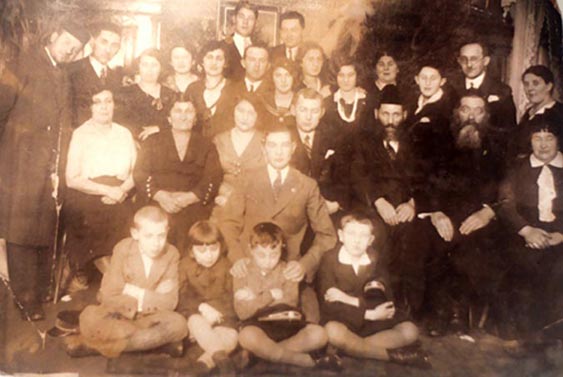
Mr. Icek Szubinski (my father) at the very back left hand side.
Awram Szubinski and Chana Szubinska (my grandfather and
grandmother) - front row seated on chairs on the right hand side.
Szlomo Szubinski (my uncle) in the centre of the fron row, with a smart
light suit.
The two children in the middle of the front row, seated on the ground, I think
are Heindrick Szubinski and Blumcha Szubinski, my cousins, who
perished in the Holocaust, Heindrick in Posen and Blumcha in
Chelmno.
In the picture appears also be their father Mosze Szubinski
and their mother Genia, née
Dzialoshinski, also perished in
Chełmno.
My aunt, Rachel Rubinstein (née
Szubinski) and her husband and children are
also pictured. Rachel perished at
Treblinka.
Unfortunately I do not know for sure who all the others are but I did have
another uncle Szulem and his wife Edith, who may be in the picture
and other relatives I do not know about.
I think the picture was taken in 1933 on the eve of my uncle Szlomo's
emigration to Palestine.
![]()
Bais Yaakov בית יעקב Girls School in Turek
Photograph and captions contributed by Bronia (Brucha) Kibel with Susan Pentlin, PhD
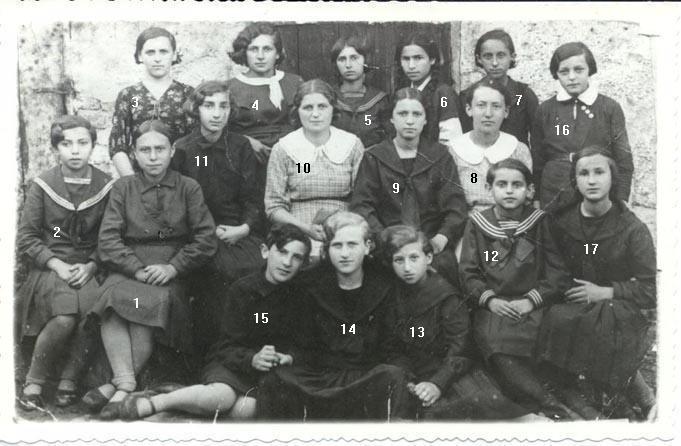
Hebrew School for Orthodox
Girls in Turek, Poland. The younger girls were basu, the older ones
benos. Probably taken in 1938 or 1939. (1) Bronia Kibel is wearing a dark
dress.2) the girl wearing a sailor suit on the left was Sura Precel, (3) This
student was older and Bronia has forgotten her name. Then there is (4) Mania
Neiman whose father made and sold pots and pans. She was Bronia's best friend
(5) Henja Rakowna, then (6) Henja Lepkowitz (turned to the side), (7)
Henja
Włójczka (8)? Urbach is wearing a white collar. She was red-headed. (9) ?
Działoszinska is seated next to her. She wore two braids. (10) Sura Zomer
(Somer) was the group leader. She is also wearing a white collar. Zomer married
a man named Rosenzweig and they went to Israel.There were three Zomer
sisters. They lived in the
Kałagass
(Kaliska in Polish). To Zomer's left is a (11)? Pulwermacher. She also
survived. Seated on the front row is:(12) the little girl in the sailor dress.
Bronia does not remember her name. To her left is (13) Surcia Weinstein, then in
the middle is (14) Czecia Speyer (she had an older sister named Mila) and (15) on
her right is a new student named ? Karbonkel. She was from Cracow. Her father
was a lawyer. (16) is a girl from the Kiwala family. (17) Hannah
Ruchal Kibel, a cousin of Bronia's. Her parents were Mordechai
and Cirla Kibel, Bronia's aunt and uncle. Cirla was also a
Kibel by birth and she came from Zdunska Wola.
The photograph was published in a book in Kansas City called From the Heart but only Bronia Kibel is identified in that book. Then Bronia Kibel identified the other girls.
The photograph appears in the book where the photo appears at the book:
From the Heart : Life Before and After the Holocaust - A Mosaic of
Memories (Hardcover)
by MCHE - Midwest Center for Holocaust Education,
Published by The Kansas City Star, 2001. The book can be ordered from the
Midwest Center for Holocaust Education 5801 West 115th Street, Suite 106
Overland Park, KS 66211-1800 Phone (913) 327-8190 Fax (913) 327-8193
It can be ordered at:
http://www.mchekc.org
This is the same web site where a realplayer
clip of Bronia is
located. And there is also a video of Kansas City survivors produced by the
Center which has Bronia on it: Through our Own Eyes which can be ordered
on the site.
I thank the MCHE Executive Director for the jpeg of the photo, Jean Zeldin;
email: jeanz@mchekc.org. The photo itself belongs to Bronia. She gave MCHE
permission to send Susan Peltin the jpeg for the the zchor web site.
![]()
Turek Association of Israel ("Landsmanschaft") erected a memorial at the Jewish Cemetery in Turek. The mayor, local dignitaries, the rabbi of Lodz, and a delegation of Israeli Turek descendants attended the dedication on 25 Aug. 2003. No Matzevot (Tombstones) remain in the cemetery. A few original stones stand at the Chelmno Memorial, the site where the majority of Turek Jews perished.
Susan Pentlin PhD

The commemoration of the Jewish cemtery thanks to the Turek municipality,
Machra Adamow and descendants of the families:
Aberstein, Bikowski, Widawski, Seife, Jachimowicz,
Marber, Trzaskala, Kibel, Rozencwajg (Podchalebnik), Szmul,
Szubinski, Apt, Guttmacher, Plotka, Rasz, L. Seiffe
|
The memorial monument in the
Turek cemetry, made out of broken Matzevot (Moshe Shubinsky to the
left) |
The mission group for the dedication ceremony, August 2003 |
![]()
|
View of old Market Square in Turek, Poland looking west. 2003. To the left, is the town hall. |
View of old Market Square in Turek, Poland looking east. 2003. In the center, is the Catholic Cathedral, built in 1910. |
|
Source: They were taken by Marcus Byruck, whose grandfather was Meyer Shlomo Bajrach of Turek, Poland when he was in Turek in the summer of 2003 |
|
http://www.konin.pl/konin/miasto/muzeum.htm
Tel: +48 63 2427599 Fax: +48 63 2427431
Muzeum Okręgowe w Koninie
62-505 Konin ul. Muzealna 6
Poland
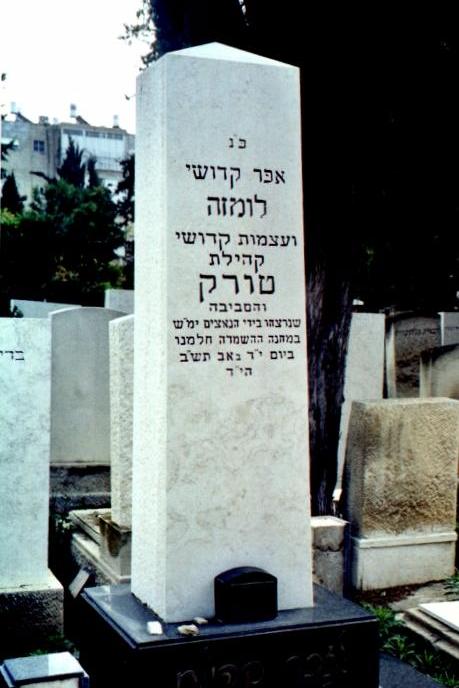
The memorial tombstone of Turek
martyrs in Nachlat Yitzhak cemetery Givataiim, Israel
"Bones of the Holocaust martyrs of Turek, murdered in Chelmno extermination camp
on Av 14, 5702
(July 28th, 1942)
I thank Ellen Stepak and Rose Feldman of the IGS for this photograph - part of the IGS project in progress:
Memorial for the Vanished Communities
LINKS
1929 Business Directory Turek (goto page 995)
JewishGen
JGFF The JewishGen Family Finder
JewishGen Yizkor Books database
![]()
First Email | Maps | History (Hebrew) | Kowale Pańskie | Kibel | Kibel's Memoirs | Szubinski | Chelmno | Landsmanschaft | Necrology Hebrew English | Yizkor Book | English | Bais Yaakov | Commemoration 2003 | Today
Last updated November 22nd, 2007